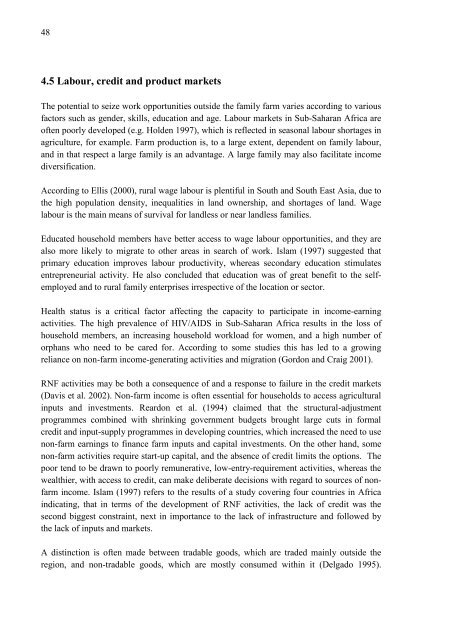Rural Income Generation and Diversification - A Case Study ... - Doria
Rural Income Generation and Diversification - A Case Study ... - Doria
Rural Income Generation and Diversification - A Case Study ... - Doria
Create successful ePaper yourself
Turn your PDF publications into a flip-book with our unique Google optimized e-Paper software.
48<br />
4.5 Labour, credit <strong>and</strong> product markets<br />
The potential to seize work opportunities outside the family farm varies according to various<br />
factors such as gender, skills, education <strong>and</strong> age. Labour markets in Sub-Saharan Africa are<br />
often poorly developed (e.g. Holden 1997), which is reflected in seasonal labour shortages in<br />
agriculture, for example. Farm production is, to a large extent, dependent on family labour,<br />
<strong>and</strong> in that respect a large family is an advantage. A large family may also facilitate income<br />
diversification.<br />
According to Ellis (2000), rural wage labour is plentiful in South <strong>and</strong> South East Asia, due to<br />
the high population density, inequalities in l<strong>and</strong> ownership, <strong>and</strong> shortages of l<strong>and</strong>. Wage<br />
labour is the main means of survival for l<strong>and</strong>less or near l<strong>and</strong>less families.<br />
Educated household members have better access to wage labour opportunities, <strong>and</strong> they are<br />
also more likely to migrate to other areas in search of work. Islam (1997) suggested that<br />
primary education improves labour productivity, whereas secondary education stimulates<br />
entrepreneurial activity. He also concluded that education was of great benefit to the selfemployed<br />
<strong>and</strong> to rural family enterprises irrespective of the location or sector.<br />
Health status is a critical factor affecting the capacity to participate in income-earning<br />
activities. The high prevalence of HIV/AIDS in Sub-Saharan Africa results in the loss of<br />
household members, an increasing household workload for women, <strong>and</strong> a high number of<br />
orphans who need to be cared for. According to some studies this has led to a growing<br />
reliance on non-farm income-generating activities <strong>and</strong> migration (Gordon <strong>and</strong> Craig 2001).<br />
RNF activities may be both a consequence of <strong>and</strong> a response to failure in the credit markets<br />
(Davis et al. 2002). Non-farm income is often essential for households to access agricultural<br />
inputs <strong>and</strong> investments. Reardon et al. (1994) claimed that the structural-adjustment<br />
programmes combined with shrinking government budgets brought large cuts in formal<br />
credit <strong>and</strong> input-supply programmes in developing countries, which increased the need to use<br />
non-farm earnings to finance farm inputs <strong>and</strong> capital investments. On the other h<strong>and</strong>, some<br />
non-farm activities require start-up capital, <strong>and</strong> the absence of credit limits the options. The<br />
poor tend to be drawn to poorly remunerative, low-entry-requirement activities, whereas the<br />
wealthier, with access to credit, can make deliberate decisions with regard to sources of nonfarm<br />
income. Islam (1997) refers to the results of a study covering four countries in Africa<br />
indicating, that in terms of the development of RNF activities, the lack of credit was the<br />
second biggest constraint, next in importance to the lack of infrastructure <strong>and</strong> followed by<br />
the lack of inputs <strong>and</strong> markets.<br />
A distinction is often made between tradable goods, which are traded mainly outside the<br />
region, <strong>and</strong> non-tradable goods, which are mostly consumed within it (Delgado 1995).

















